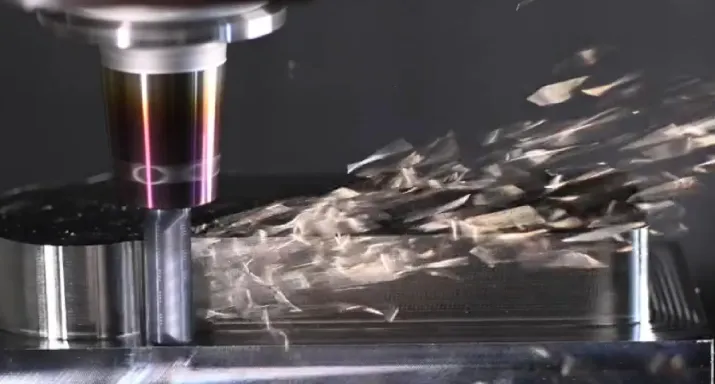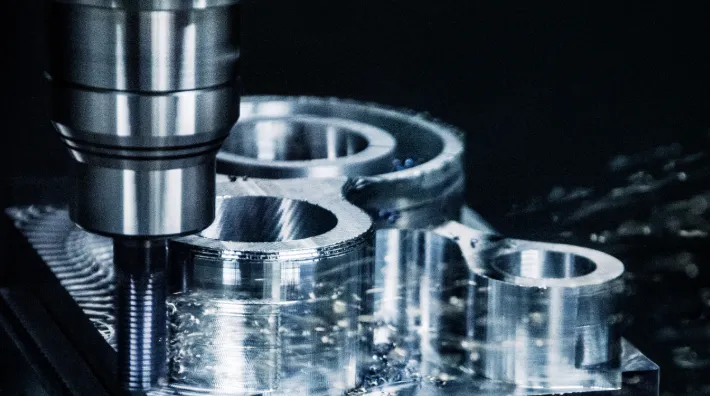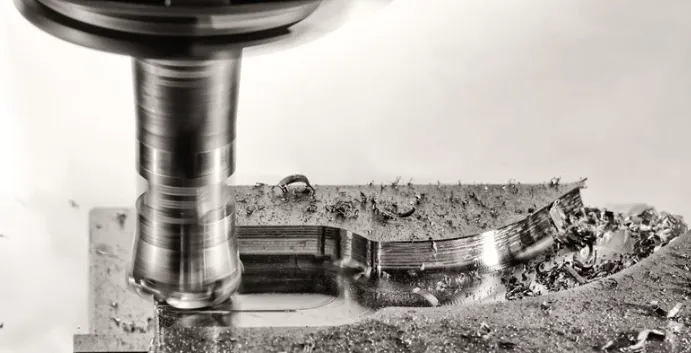High speed machining (HSM) represents a sophisticated manufacturing paradigm that redefines traditional cutting processes through optimized kinematics, advanced tooling systems, and precisely controlled dynamic interactions between the cutting tool and workpiece. This technology is empirically characterized by spindle speeds typically exceeding 10,000 RPM (reaching 60,000 RPM for micro-machining applications), feed rates surpassing 20 m/min (with some aerospace aluminum applications achieving 50 m/min), and material removal rates (MRR) that can be 3-5 times greater than conventional machining while maintaining or improving surface finish quality. The fundamental physics of HSM leverages the phenomenon where cutting temperatures peak at certain speed thresholds before decreasing, allowing efficient material removal when operating within optimized parameter windows that vary by material – approximately 500-1,500 m/min for aluminum alloys, 300-800 m/min for steels, and 100-300 m/min for titanium alloys.
Modern high speed machining centers incorporate robust machine structures with natural frequencies above 100 Hz to avoid resonant vibrations during aggressive material removal, utilizing polymer concrete or epoxy granite bases that provide 3-5 times better vibration damping than traditional cast iron. High-performance spindle designs employ hybrid ceramic bearings (silicon nitride balls with steel races) or active magnetic bearing systems capable of maintaining rotational accuracies below 1 μm TIR (Total Indicator Runout) at maximum speeds, with integral cooling channels that control thermal growth to within 5 μm during extended operation. Linear motor drives replace conventional ball screws in advanced HSM machines, providing acceleration rates exceeding 2 g (20 m/s²) and rapid traverse speeds over 90 m/min while eliminating backlash and reducing friction-induced heat generation. The control systems utilize look-ahead algorithms processing hundreds of blocks of NC code in advance to smooth toolpath transitions, preventing deceleration marks that could compromise surface finish in complex 3D contours.
 Cutting tool technology for HSM represents a critical enabler, with substrate materials and geometries specifically engineered for high velocity conditions. Solid carbide end mills with ultrafine grain structures (0.2-0.5 μm) and high cobalt content (8-12%) provide the necessary combination of hardness (92-94 HRA) and transverse rupture strength (4,000-5,000 MPa) to withstand centrifugal forces at elevated speeds. Advanced tool coatings such as aluminum chromium nitride (AlCrN) or silicon-aluminum oxynitride (SiAlON) deposited through physical vapor deposition (PVD) processes maintain their protective properties at the 800-1,000°C interface temperatures encountered during HSM of steels. Specialized tool geometries feature variable helix angles (35-45°) and unequal pitch distributions to break up harmonic vibration patterns, while reduced neck diameters and extended flute lengths provide clearance for deep cavity machining without sacrificing rigidity. Tool holding systems employ precision hydraulic chucks or thermal shrink-fit technology that achieve gripping accuracies under 3 μm TIR at maximum rotational speeds, with balanced tool assemblies maintaining G2.5 or better balance quality to prevent destructive vibrations.
Cutting tool technology for HSM represents a critical enabler, with substrate materials and geometries specifically engineered for high velocity conditions. Solid carbide end mills with ultrafine grain structures (0.2-0.5 μm) and high cobalt content (8-12%) provide the necessary combination of hardness (92-94 HRA) and transverse rupture strength (4,000-5,000 MPa) to withstand centrifugal forces at elevated speeds. Advanced tool coatings such as aluminum chromium nitride (AlCrN) or silicon-aluminum oxynitride (SiAlON) deposited through physical vapor deposition (PVD) processes maintain their protective properties at the 800-1,000°C interface temperatures encountered during HSM of steels. Specialized tool geometries feature variable helix angles (35-45°) and unequal pitch distributions to break up harmonic vibration patterns, while reduced neck diameters and extended flute lengths provide clearance for deep cavity machining without sacrificing rigidity. Tool holding systems employ precision hydraulic chucks or thermal shrink-fit technology that achieve gripping accuracies under 3 μm TIR at maximum rotational speeds, with balanced tool assemblies maintaining G2.5 or better balance quality to prevent destructive vibrations.
Process dynamics in high speed machining differ fundamentally from conventional cutting operations. The chip formation mechanism transitions to a more efficient shear process where the heat generated remains primarily concentrated in the chip rather than the workpiece or tool, with shear zone temperatures reaching 600-800°C in aluminum alloys but with contact durations reduced to milliseconds. This produces thin, segmented chips that are efficiently evacuated by high-pressure coolant systems (70-150 bar) or air blast methods, preventing chip re-cutting that could degrade surface finish. Cutting forces in HSM demonstrate unique characteristics – while the tangential cutting force component may decrease by 20-30% compared to conventional speeds due to thermal softening effects, radial forces become more significant and require careful management through tool path strategies to prevent tool deflection. Surface integrity benefits from HSM parameters, with residual compressive stresses typically 20-50% higher than conventional machining in aerospace alloys, and surface roughness values (Ra) often improving to 0.2-0.4 μm in finish operations due to reduced built-up edge formation.

Industrial applications of high speed machining span multiple sectors where productivity and precision requirements justify the technology investment. Aerospace manufacturers extensively employ HSM for aluminum structural components, achieving material removal rates of 1,500-3,000 cm³/min in bulk roughing operations while maintaining thin-wall machining capabilities for ribbed structures as narrow as 1 mm with positional tolerances of ±0.025 mm. The mold and die industry utilizes HSM for hardened tool steels (45-55 HRC), combining high spindle speeds (15,000-30,000 RPM) with small diameter tools (0.5-3 mm) to machine intricate cavities with surface finishes below 0.5 μm Ra, eliminating manual polishing operations. Medical device manufacturers leverage HSM’s capability for micromachining titanium and cobalt-chrome implants, producing complex bone screw threads and porous surface structures with feature sizes down to 50 μm. Even automotive high-volume production benefits from HSM through reduced cycle times in cylinder head machining and transmission component manufacturing, where the technology enables complete machining of aluminum parts in single setups with tool life improvements of 30-50% compared to conventional parameters.

The implementation of successful high speed machining requires comprehensive system integration beyond just the machine tool. CAD/CAM systems must generate optimized toolpaths that maintain constant tool engagement angles (typically 30-45° for roughing, 5-15° for finishing) to prevent sudden load variations that could cause tool fracture. Simulation software performs virtual machining analyses to predict and avoid dynamic instabilities, with advanced packages calculating stability lobe diagrams that identify optimal spindle speed ranges for chatter-free operation. Workholding systems must provide sufficient clamping force (often 5-10 times the estimated cutting forces) while allowing access for high-velocity chip evacuation, with vacuum fixtures or customized modular clamping frequently employed. Coolant delivery systems require careful design – through-tool coolant passages (0.8-1.2 mm diameter) positioned within 1 mm of the cutting edge ensure effective heat removal and chip breaking at high speeds, with filtration systems maintaining particle sizes below 10 μm to prevent nozzle clogging.

Technological advancements continue to push the boundaries of high speed machining capabilities. Five-axis HSM centers now incorporate dynamic accuracy compensation systems that adjust for positional errors in real-time based on thermal and load sensors throughout the machine structure. Intelligent tool monitoring systems analyze spindle power consumption, vibration signatures, and acoustic emissions to detect tool wear or breakage within milliseconds, automatically adjusting parameters or stopping the process before workpiece damage occurs. The development of new tool materials like nano-grained tungsten carbide with grain sizes below 100 nm promises further improvements in high-temperature hardness and fracture resistance. Hybrid machining systems combine HSM with laser assistance or ultrasonic vibration to extend the technology’s application to difficult-to-machine materials like Inconel 718 or titanium aluminides, where conventional HSM parameters would result in excessive tool wear.
Economic considerations for high speed machining implementation involve careful analysis of the total cost structure. While machine tool investments may be 30-50% higher than conventional machining centers, the productivity gains often justify the expenditure – typical ROI periods range from 18-36 months in production environments. Tooling costs per part are frequently lower in HSM despite higher initial tool prices, as the reduced cutting forces and optimized heat management extend tool life significantly. Energy consumption per cubic centimeter of material removed proves more efficient in HSM, with power requirements decreasing by 15-25% compared to conventional machining when operated within optimal parameter windows. The technology also enables substantial indirect cost savings through reduced floor space requirements (higher productivity per machine), decreased work-in-process inventory (faster cycle times), and improved part quality that minimizes scrap and rework.

Future developments in high speed machining focus on expanding the technology’s applicability across more material classes and manufacturing scenarios. Research into cryogenic cooling methods using liquid nitrogen or CO2 seeks to enable HSM of materials currently limited by excessive tool wear, such as high-silicon aluminum alloys or metal matrix composites. The integration of artificial intelligence for adaptive process control promises to automatically optimize speeds, feeds, and toolpaths in real-time based on continuous sensor feedback. Advancements in machine tool metrology, including laser interferometer-based volumetric error compensation, aim to push HSM accuracy levels to new benchmarks – potentially achieving micron-level precision at production-scale speeds. As these innovations mature, high speed machining is poised to become even more pervasive across manufacturing sectors, continuing its transformative impact on production efficiency, part quality, and manufacturing economics.




